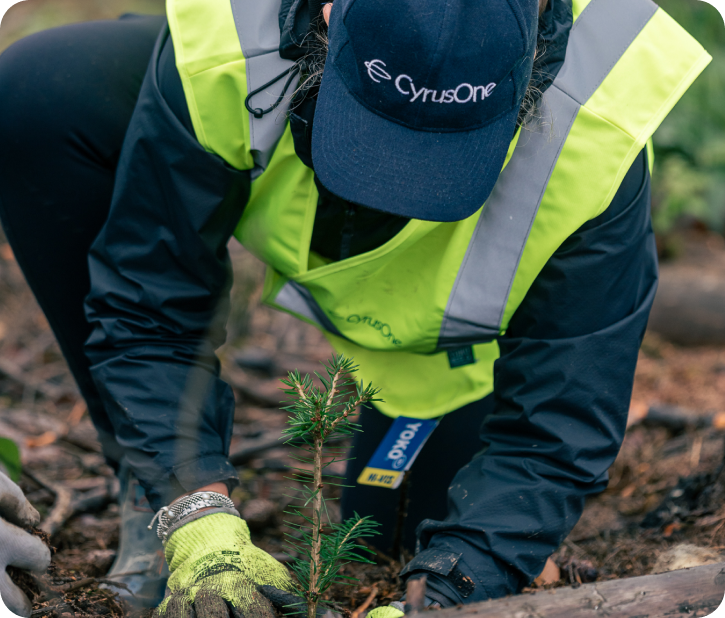From April 25–27, Data Cloud Congress reunited international leaders and actors of the data center industry in one place: Monaco. A key conversation was held on sustainability and the greener future of facilities. How do we achieve such a transition in an ever-evolving and ever-more digitalized world? According to Tom Kingham, CyrusOne’s Solutions Engineering Director, it starts with “doing the right thing rather than the necessary thing”. Let’s dig into this.
Often mystified by the broader public, data centers have become an irreplaceable component of our society. They provide governments and organizations with the computing, storage, and network capabilities needed to deliver their data, services, and applications while offering the protection of advanced security – but not only that. Data centers allow everyday consumers to shop online, work from home, as well as access education, banking services, and certain health services remotely. Today, there are an estimated 7.2 million data centers worldwide to meet this demand. Due to the global shift towards reducing energy consumption and achieving net zero, the industry is constantly innovating and developing new technologies to improve sustainability. Market leaders are constantly focusing on invention, research, and the creation of new opportunities.
Current challenges for data centers
European players in the data center market have no choice, they will have to rethink their current operations: from the water-cooling system to the energy consumption. Local data centers will have to align themselves with the European Union's policy and decision to be carbon neutral by 2030. 7 years to change and reinvent an industry in constant evolution. These actions are necessary and will obviously come at a cost, but is this really a concern? For Tom Kingham, CyrusOne’s Solutions Engineering Director, we should be “doing the right thing rather than the necessary thing. We should worry less about the cost and more about making sure we are good custodians of the land and of the resources consumed at the facilities. The cost of not being sustainable is greater than being sustainable.”
Right now, the biggest challenge is not as much about achieving more sustainable results as it is about demonstrating that this is the case. The industry measures its energy consumption with a metric called Power Utilisation Effectiveness (PUE), which is expressed as a number and represents the ratio of total facility power divided by the amount of energy used to power hardware and systems. The more efficient a data center is, the lower its PUE score, which can range from 3.0 to 1.2. If a data center's score is higher than 2.0, it means that it is actually using more energy to support its core infrastructure than it is supplying to its frontline ICT equipment.
The importance of holding ourselves accountable and setting clear targets
Although more and more solutions and tools have been created to support industry players, it all started with setting clear and tangible goals. When asked about adopting a global approach, Tom Kingham said that “from a competitive point of view, it’s about holding each other accountable to the same goals, such as the Climate Neutral Data Center Pact (CNDCP) metrics. This is a great start, and to some degree, it removes the cost element of investing in sustainability because everyone is on the same playing field.”
As a result of the growing interest of market leaders in Europe and their willingness to join forces to achieve climate neutrality by 2030, the Climate Neutral Data Centre Pact (CNDCP) was created back in January 2021. The pact has a wide scope, covering energy efficiency, water, clean energy, circular economy, and heat recovery, with data centers voluntarily joining to contribute to the goals of the European Green Deal. All data center operators that are members of the Pact are required to audit their compliance with the Pact's objectives using data collected between January 1 and December 31 following the first anniversary of their membership. The auditing process ensures that members of the Pact provide independent verification that they are meeting their commitment to making data centers climate neutral by 2030. CyrusOne has already signed on to the terms of the CNDCP and successfully passed its first compliance audit - becoming the first among the other signatories.
Educating others and working together
On top of creating metrics and setting targets, educating others is key. At the community level, it’s all about working together and finding alternatives that benefit everyone. According to Tom Kingham, “It’s about what the data center can provide for the local environment, such as heat reuse for residential heating and swimming pools. Additionally, CyrusOne is looking to build training centers in one location to train people from the local community in technology. This can contribute to communities caring more about data centers, but also developing new skills.”
From an industry perspective, it’s about acknowledging the lessons learned along the way: “The idea should be that whatever we learn as a good example in each place comes together to form a global action plan. For example, CyrusOne carried out a biodiversity project in Dublin, and that has now formed the basis of every project. Even if it’s a small piece of green area, what can we do to make it as relevant as possible? A global plan grows by taking the examples of areas where things were most important and then rolling them into the plan. However, it is still so early in the process that it’s difficult to implement important experiences from London to a place like Jakarta.”
Summary
- Sustainability Focus at Data Cloud Congress: The event in Monaco highlighted the importance of sustainability in the data center industry, with discussions on transitioning to greener facilities in a digitalized world.
- Challenges and Accountability: European data centers must align with EU policies to achieve carbon neutrality by 2030, focusing on doing the right thing over cost concerns. The industry uses Power Utilisation Effectiveness (PUE) to measure energy efficiency.
- Collaboration and Education: The Climate Neutral Data Center Pact (CNDCP) sets environmental targets, with CyrusOne leading compliance efforts. Educating communities and sharing best practices globally are key to advancing sustainability goals.
 by
by 

